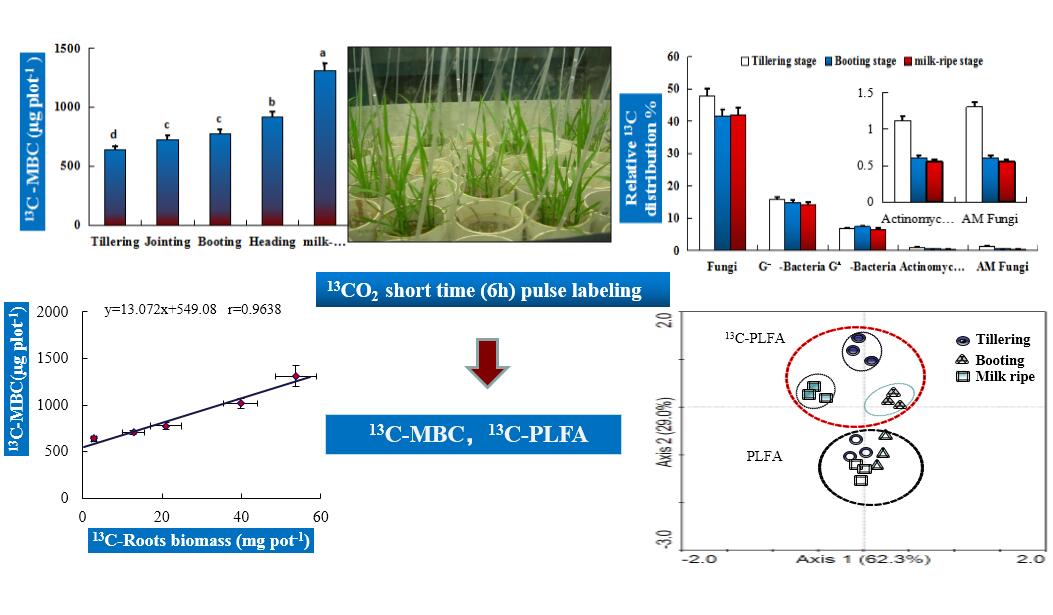First Step of Root Exudate Utilization by Rhizosphere Microorganisms Revealed by 13C Labeling of Rice
Rhizodeposits consist of a wide range of compounds, including root exudates, mucilage, sloughed cells and tissue, cell lysates, and root debris. The soluble components of root-released organics (exudates) are the most important sources of readily available carbon (C) for rhizosphere microorganisms.
The first steps of exudate utilization by microorganisms define all further flows, recycling, and stabilization of root C in soil. Nevertheless, most studies have traced root C much later after its initial uptake. Therefore, the research group from the Institute of Subtropical Agriculture, Chinese Academy of Sciences (ISA) performed 13C pulse-chase labeling of wetland rice at five growth stages under field conditions. They tested two hypotheses:one is root exudates and their microbial utilization changes during plant growth, and the other is rhizosphere bacteria outcompete fungi for initial uptake of root exudates because the reduced oxygen conditions have a repressive effect on fungi. They performed 6 hours of 13C pulse-chase labeling of wetland rice at five growth stages (active root growth (21 days after transplanting), rapid shoot growth (37 and 45 days after transplanting), and rapid reproduction (53 and 63 days after transplanting)) under field conditions. To test the first hypothesis, the pattern of 13C photosynthate distribution to shoot, roots, total soil organic matter, and microbial biomass were measured different stages of rice growth. To test the second hypothesis, the incorporation of exudates into microbial groups was traced by analyzing phospholipid fatty acids (PLFAs) shortly after 13C assimilation aboveground.
The researchers found that 13C was allocated and distributed throughout the rice-soil-microbe system very quickly, and the rate of distribution increased with rice maturity. Despite low oxygen availability in paddy soils, root exudates were utilized mainly by fungi. In all growth stages, fungal PLFAs (18:2 w6, 9c/18:0) were the most highly 13C enriched, whereas actinomycete PLFAs had the lowest 13C incorporation. Although the amount of exudation increased during rice maturation, and the C contained in the exudates was rapidly incorporated into rhizosphere microorganisms, the overall microbial community structure did not change during rice growth.
They also found that the amount of 13C recovered from soil and microbial biomass was linearly correlated with 13C in roots. This allows good assessment of rhizodeposition under field conditions based on root biomass and, therefore, can be used to estimate belowground C input and contributions to C sequestration. They conclude that rapid incorporation of 13C-labeled root exudates into microbial populations in paddy soils differs with rice growth stage and this first step of C utilization in the rice rhizosphere defines further C utilization and stabilization.
This study entitled "Microbial utilization of rice root exudates: 13C labeling and PLFA composition" has been online in Biology and Fertility of Soils (doi: 10.1007/s00374-016-1101-0). The reviwer comments the issue is rather interesting since it concerns growing of rice plants under flooding, a condition less investigated in comparison with rhizodeposition studies in crops growing on dryland soils. The experiment is well-designed and executed. The results reported in the Tables and Figures are robust and convincing."The full-text can be download at http://link.springer.com/article/10.1007/s00374-016-1101-0.
This study was supported financially by the National Natural Science Foundation of China (41430860; 41301275) and Royal Society Newton Advanced Fellowship (NA150182).

First Step of Root Exudate Utilization by Rhizosphere Microorganisms Revealed by 13C Labeling of Rice
Contact: GE Tida
E-mail: gtd@isa.ac.cn
Institute of Subtropical Agriculture, Chinese Academy of Sciences
Download attachments: